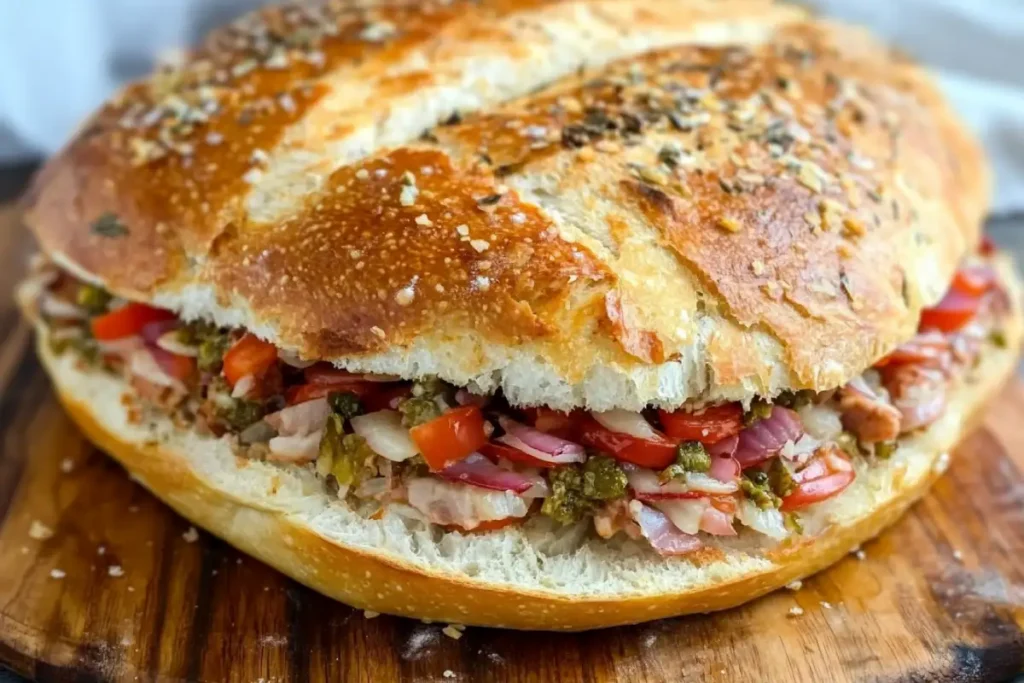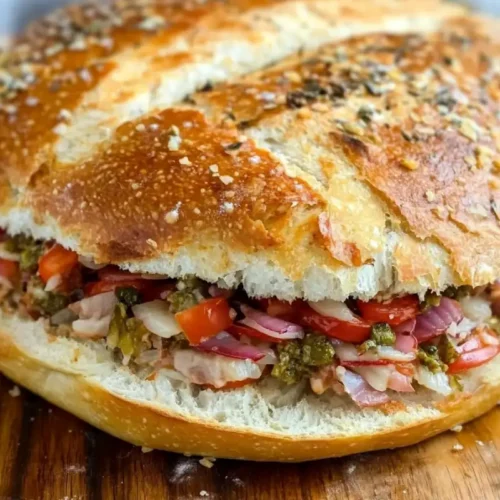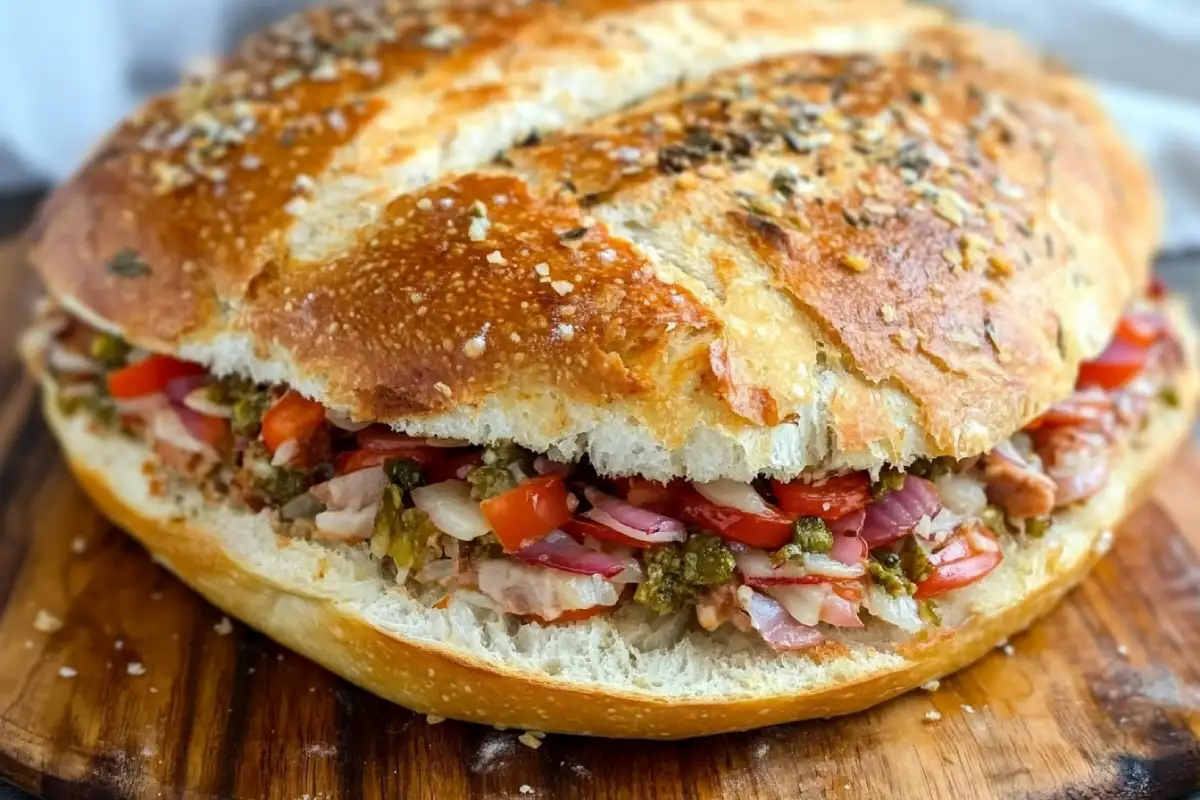
Table of Contents
Perfect muffaletta bread is more than a sesame round; it’s a soft-crumb loaf sturdy enough to hold olive salad without getting soggy. After three hydration trials I locked in a 70 % dough that proofs in 75 minutes and bakes with a thin, springy crust—ideal for supersized sandwiches or dinner rolls alike.
What Kind of Bread is on a Muffaletta?
If you’ve ever had a muffuletta sandwich, you know that the bread plays a crucial role. Unlike traditional sandwich bread, muffaletta bread is a large, round, sesame-seeded loaf with a firm crust and a soft, airy interior. It is sturdy enough to hold layers of meat, cheese, and olive salad without becoming soggy.
What Makes Muffaletta Bread Unique?
Several key features set muffuletta sandwich bread apart from other types of bread:
- Size & Shape: Typically, it is about 10 inches in diameter, making it perfect for slicing into quarters or halves.
- Texture: While the crust is firm, the inside remains light and slightly chewy, ensuring a great balance between softness and structure.
- Flavor: The subtle richness from olive oil and the nutty crunch of sesame seeds give muffaletta bread its signature taste.
Because the bread is so important, some people wonder about alternatives. If you’re curious about what works as a muffuletta bread substitute, check out this guide on mini muffaletta sandwiches for creative variations.
Where Can You Find Authentic Muffaletta Bread?
If you’re making a muffuletta sandwich at home, you have a few options:
- Bakeries in New Orleans – Many local bakeries specialize in traditional muffaletta bread.
- Online Retailers – Some companies offer muffuletta bread for sale, shipping it nationwide.
- Homemade Versions – If you want to bake your own, you can follow a classic muffaletta bread recipe to get the best results.
Whether you’re enjoying an authentic New Orleans sandwich or experimenting with different bread for muffaletta sandwich, the right choice makes all the difference!
How to Make Muffaletta Bread
Making muffaletta bread from scratch is a rewarding process that lets you enjoy the authentic flavors of New Orleans-style cuisine. With just a few simple ingredients and the right technique, you can create a homemade loaf that’s perfect for layering meats, cheeses, and olive salad.
Essential Ingredients for Muffaletta Bread
To achieve the traditional taste and texture, you’ll need the following:
| Ingredient | Purpose |
|---|---|
| Bread flour | Provides structure and chewiness |
| Yeast | Helps the dough rise for a light texture |
| Sugar | Feeds the yeast and adds a hint of sweetness |
| Olive oil | Enhances flavor and creates a tender crumb |
| Salt | Strengthens gluten and balances flavors |
| Sesame seeds | Adds a nutty crunch and signature look |
Step-by-Step Recipe for Homemade Muffaletta Bread
To get started, follow these simple steps:
- Activate the Yeast – In a bowl, combine warm water, yeast, and sugar. Let it sit for 5-10 minutes until foamy.
- Mix the Dough – Add bread flour, salt, and olive oil to the yeast mixture. Stir until a rough dough forms.
- Knead Thoroughly – Knead the dough on a floured surface for about 8-10 minutes until it becomes smooth and elastic.
- First Rise – Place the dough in a greased bowl, cover with a towel, and let it rise for 1-2 hours or until it doubles in size.
- Shape the Loaf – Punch down the dough, shape it into a large round disc, and place it on a baking sheet.
- Second Rise – Cover and let it rise again for about 30 minutes.
- Add Sesame Seeds – Brush the top with water or an egg wash and sprinkle generously with sesame seeds.
- Bake to Perfection – Bake in a preheated oven at 375°F (190°C) for 25-30 minutes until golden brown.
- Cool Before Slicing – Let the bread cool completely before slicing to prevent a gummy texture.
Pro Tips for the Best Muffaletta Bread
- Use high-quality olive oil for the most authentic flavor.
- Let the dough rise fully to achieve the right texture—rushing the process can result in a dense loaf.
- Bake on a pizza stone for a crispier crust.
- Store properly by wrapping it in foil or keeping it in an airtight container to maintain freshness.
If you’re curious about the full muffuletta sandwich experience, check out this detailed guide on muffuletta sandwich calories to learn more about its nutritional profile.
Best Bread for Muffaletta
When making the perfect muffuletta sandwich, the choice of bread is just as important as the ingredients inside. The best option is, of course, authentic muffaletta bread. However, if you don’t have access to it, there are a few alternatives that can work well while still maintaining the right texture and flavor balance.
Why Muffaletta Bread is Ideal?
To understand why muffaletta bread is the best choice, consider its unique characteristics:
| Feature | Why It Matters |
|---|---|
| Size & Shape | Large and round, allowing for multiple layers of fillings |
| Texture | Crispy crust with a soft, airy interior, preventing sogginess |
| Flavor | Lightly seasoned with olive oil and sesame seeds for added depth |
| Structure | Firm enough to hold meats and cheeses without falling apart |
Alternatives to Muffaletta Bread
If you can’t find muffaletta bread, don’t worry—there are a few excellent substitutes that can still deliver a satisfying sandwich experience:
1. Ciabatta
✅ Pros: Light and airy texture, similar to muffaletta bread.
❌ Cons: Has a thinner crust, which may not hold fillings as well.
2. Focaccia
✅ Pros: Rich in olive oil flavor and often topped with herbs for extra taste.
❌ Cons: Can be too thick, making it harder to bite into a fully loaded sandwich.
3. French Boule
✅ Pros: Round shape and firm crust mimic traditional muffuletta bread.
❌ Cons: Slightly denser interior, which can make the sandwich heavier.
4. Italian Round Loaf
✅ Pros: Closely resembles the texture and size of muffaletta bread.
❌ Cons: Some versions may lack sesame seeds, which are essential for authenticity.
Muffuletta Bread for Sale: Where to Buy It?
For those who want to enjoy an authentic muffuletta sandwich but don’t have time to bake their own muffaletta bread, there are several options available. While this specialty bread is easiest to find in New Orleans, many bakeries and online retailers offer shipping nationwide.
Where to Find Authentic Muffaletta Bread
If you’re looking for freshly baked muffuletta bread, consider these options:
- Local Bakeries
- New Orleans Bakeries – The best place to find traditional muffaletta bread is in New Orleans, where Italian bakeries and delis specialize in this classic loaf.
- Italian Bakeries Nationwide – Many Italian bakeries outside Louisiana offer similar round, sesame-seeded loaves.
- Online Retailers
- Some bakeries in New Orleans ship authentic muffaletta bread nationwide.
- Online specialty food stores sometimes carry pre-baked loaves, making it easy to recreate the sandwich at home.
- Grocery Stores & Markets
- While mainstream supermarkets may not carry true muffuletta bread, some high-end grocery stores with a bakery section might have suitable alternatives.
- Farmers’ markets or gourmet food shops could also be good sources.
What to Look for When Buying Muffaletta Bread
To ensure you’re getting the best quality bread for your sandwich, keep these factors in mind:
✔ Size & Shape – A proper muffaletta bread loaf should be round and large, approximately 10 inches in diameter.
✔ Crust & Texture – The crust should be firm but not too hard, while the interior should be light and slightly chewy.
✔ Sesame Seeds – Traditional loaves are topped with sesame seeds, which add both flavor and authenticity.
✔ Freshness – If buying online, check for shipping details to ensure freshly baked bread, rather than pre-packaged versions with preservatives.
Frequently Asked Questions (FAQs) About Muffaletta Bread
What Kind of Bread Is on a Muffaletta?
The bread used for a muffuletta sandwich is a large, round, sesame-seeded loaf known as muffaletta bread. It has a crispy crust and a soft, airy interior, making it ideal for holding layers of meats, cheeses, and olive salad without becoming soggy. While it’s unique to New Orleans, similar breads like Italian round loaves or French boule can be used as substitutes.
What Is a Substitute for Muffaletta Bread?
If authentic muffaletta bread isn’t available, good alternatives include an Italian round loaf for the closest match, ciabatta for its light texture, focaccia for its rich olive oil flavor, and French boule for its firm crust. While each has slight differences, baking your own muffaletta bread remains the best way to achieve authenticity.
Why Is It Called Muffaletta?
The name muffaletta (or muffuletta) comes from Sicilian dialect, derived from the word “muffa,” which means soft or spongy—a reference to the bread’s light yet chewy texture. The sandwich itself was first created in the early 1900s at Central Grocery in New Orleans, where Sicilian immigrants combined their traditional bread with Italian meats, cheeses, and olive salad.
Is Muffaletta French or Italian?
Despite New Orleans’ deep French influence, muffaletta bread and the sandwich itself are Italian in origin. The Sicilian community in Louisiana brought this bread-making tradition with them, using round, sesame-topped loaves similar to those found in Sicily. However, French baking techniques also shaped New Orleans’ overall bread culture, making the muffuletta sandwich a true Italian-American creation with a New Orleans twist.
Where can i buy muffaletta bread?
You can buy muffaletta bread at Central Grocery, Gambino’s Bakery, NolaCajun.com, Goldbelly, and select grocery stores like Whole Foods and Trader Joe’s.
Where Can I Find the Best Muffuletta in New York?
You can find the best muffuletta in New York at top Italian delis and specialty sandwich shops. Places like Faicco’s Italian Specialties, Primo’s, and Ends Meat serve authentic versions with high-quality meats, cheeses, and olive salad. Whether you prefer a traditional Central Grocery-style muffuletta or a unique NYC twist, the city offers plenty of delicious options to explore.
Conclusion
Muffaletta bread is more than just a sandwich component—it’s a key part of New Orleans’ rich culinary history. This round, sesame-seeded loaf perfectly balances a crisp crust with a soft, airy interior, making it the ideal foundation for the famous muffuletta sandwich.
Throughout this guide, we’ve explored:
- The origins of muffaletta bread, tracing its roots back to Sicilian immigrants in New Orleans.
- How to make it at home, including key ingredients and baking techniques.
- The best substitutes, in case you can’t find authentic muffaletta bread in stores.
- Where to buy it, from local bakeries to online retailers.
Whether you choose to bake your own loaf or purchase it from a trusted source, using the right bread ensures an authentic experience. A well-made muffuletta sandwich is not just about the fillings—it’s about the perfect blend of flavors, textures, and tradition.

Muffaletta Bread Recipe
Ingredients
- 3 ½ cups Bread flour High-protein flour for structure
- 1 ¼ cups Warm water Around 110°F for yeast activation
- 2 ¼ tsp Active dry yeast One packet
- 2 tbsp Sugar Helps activate yeast
- 1 ½ tsp Salt Enhances flavor
- 2 tbsp Olive oil Adds softness and flavor
- 2 tbsp Sesame seeds Traditional topping
Instructions
Step 1: Activate the Yeast
- In a small bowl, combine warm water, sugar, and yeast. Stir lightly and let it sit for 5-10 minutes, until foamy.
Step 2: Make the Dough
- In a large mixing bowl, whisk together flour and salt.
- Add the yeast mixture and olive oil. Stir until a rough dough forms.
- Knead for 8-10 minutes (by hand or in a stand mixer) until the dough is smooth and elastic.
Step 3: First Rise
- Place the dough in a greased bowl, cover with a clean towel, and let it rise for 1 ½ to 2 hours, until doubled in size.
Step 4: Shape the Bread
- Punch down the dough and shape it into a 10-inch round loaf.
- Place it on a parchment-lined baking sheet and let it rise for another 30 minutes.
Step 5: Add Sesame Seeds & Bake
- Brush the top lightly with water or olive oil. Sprinkle sesame seeds generously over the surface.
- Bake in a preheated 375°F (190°C) oven for 25-30 minutes, or until golden brown and sounds hollow when tapped.
Step 6: Cool & Serve
- Let the bread cool completely before slicing. Enjoy with your favorite muffuletta sandwich fillings!
Notes
- For extra crispiness, bake with a small tray of water in the oven to create steam.
- If you don’t have bread flour, you can use all-purpose flour, but the texture will be slightly softer.
- Store leftovers in an airtight container at room temperature for up to 3 days or freeze for later use.

